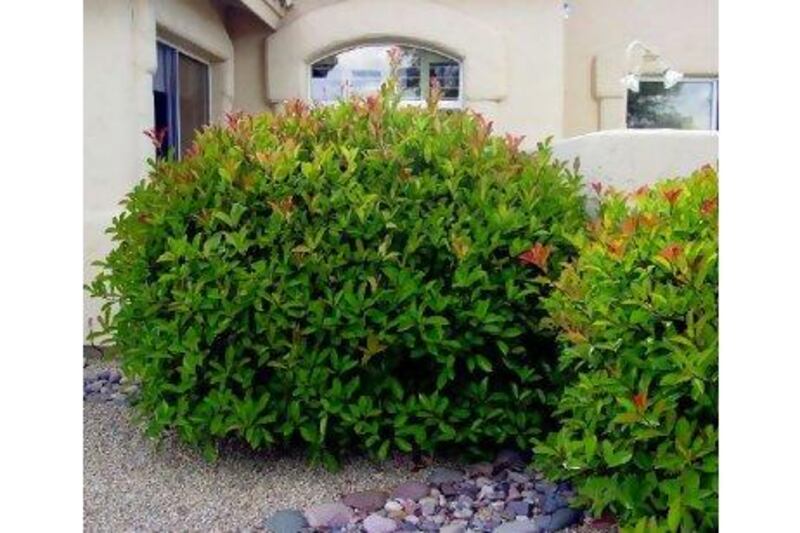The beach morning glory and hop bush take on dramatically different characteristics depending on the direction from which they are viewed - and they are remarkably drought tolerant, writes Nick Leech
Like many ubiquitous plants, the hop bush (Dodonea viscosa) is more often used than appreciated. Grown mainly as a low- to medium-height hedge, it's a plant whose contribution to the structure of many planting schemes often goes unnoticed, especially when it acts as a foil for more spectacular neighbours. But to overlook Dodonea in this way not only does this hard-working plant a serious disservice, but also means missing out on one of the most spectacular sights that the garden has to offer at this time of year.
Like a handwoven carpet, Dodonea effectively changes colour depending upon the direction from which it is seen. When viewed with the sun behind you, Dodonea is, admittedly, a rather unremarkable shrub. However, when it's viewed in the opposite direction the plant is transformed. The new growth - a fringe of upright, elliptical leaves - stands at its edges, defined and backlit. Suddenly, each leaf shines with a chartreuse brilliance like a crude but playful brushstroke of pure colour. It's as if the plant had suddenly been rendered by van Gogh and it's a sight that's impossible to miss in any garden once you've noticed it for the first time.
A similarly luminous effect can be seen through the foliage of the goat's foot vine, or beach morning glory, as it is also known (Ipomoea pes-caprae) - a sprawling, rampant plant that seems to grow where nothing else will but that also makes one of the best ground covers I've seen in the UAE. Its lobed, leathery leaves (which look rather like the imprint of a goat's hoof) have an almost glaucous finish but, when seen with the light at their backs, appear translucent and display a rich tracery of veins that's possible to see from some distance once you know what to look for.
To those familiar with other members of the Convolvulus family it will come as no surprise that Ipomoea pes-caprae can be a thug and that it needs containment and regular pruning if it isn't to run wild. It grows most often just above the high tide line along beaches, where it forms large mats that help to stabilise the sand. It sends out stolons along the ground that have been known to spread for 30 metres. Ipomoea pes-caprae is also able to develop deep tap roots that can reach a metre below the surface and that help to make it surprisingly drought tolerant for a plant that is so closely associated with the ocean. It is also highly resistant to heat, salt and wind and can tolerate the very worst soils, which makes it ideally suited to growing conditions in the UAE.
Though it's not a plant for a small garden, where there is space Ipomoea pes-caprae outperforms many of the more anonymous, carpet-like ground covers by virtue of its upright habit, delightful visual texture (it looks like a crop of fresh salad leaves good enough to eat) and the fact that it produces delicate, funnel-shaped mauve flowers throughout much of the year.
Normally when I see plants that provide such viridity I'm suspicious because I associate them with exactly the kind of water-hungry gardening that I try to avoid. However, the great thing about both these species is that they are relatively drought tolerant. As with so many species that are frequently used in the UAE, they'll benefit hugely from regular and plentiful irrigation and will gorge themselves on as much water as you can give them. However, they can also survive with far less than the amounts that they currently receive in many corporate and municipal planting schemes.
Experiments conducted at several American universities show that even extremely drought-tolerant trees such as mesquites (which belonging to the same genus Prosopis as our native ghaf) can be among the most water-demanding plants in a landscape when provided with sufficient irrigation.
The secret to low-water-demand gardening is not only in selecting the right species but also in controlling the amount of irrigation water that they receive. Given that we are used to seeing plants in the UAE that are, for the most part, hugely over-irrigated, it would be an interesting experiment for more adventurous gardeners to see just how little water various species can survive on.
This experiment would need to be handled with care because plants that are used to plentiful irrigation will go into shock and are likely to die if they're suddenly starved of water. However, for new specimens that are known to be drought tolerant and that are planted in the cool season, why not try to use as little water as possible?
In my next column I'll be looking at alternative planting and irrigation techniques that can help to achieve just this type of saving.










